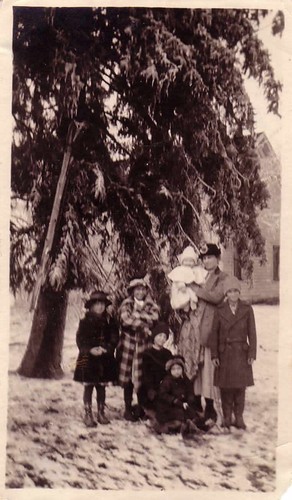 The Gallup family line can be traced back to the 1400's. Here is the ancestory of John Gallop, from Gallup Genealogy (1987):
The Gallup family line can be traced back to the 1400's. Here is the ancestory of John Gallop, from Gallup Genealogy (1987):Origin
The name is said to be derived from the German words, “Gott and Lobe,” God and praise.
“In Lorraine, part of the debatable territory between French and German people, wasted, seared, and scarred by many battles, now is possession of one people, then another. There is an ancient family of the name Kollop.”
From time immemorial the tradition has been handed down by its members from generation to generation that one of their numbers went to Western Europe as a follower of William Duke of Normandy and never returned.
As corroborative of the tradition of the Kollop family of Lorraine, a tradition also exists in the Gollop family that the founder of the English branch came into England at the conquest of France.
From Burk’s Landed Gentry
Coat of Arms
Gules, on a bend or, a lion passant guardant sable. Crest, a demi-lion barry or and sable, holding in his dexter paw a broken arrow gules. Motto: Be bolde. Be wyse.
Gules, red, taken from the color in the open mouth of the heraldic lion; bend, or bendy, signifies that the field or escutcheon, is divided by diagonal lines from the dexter chief to the sinister base, in reality a gold band five-eights of an inch in width. The field represents the shield, which was an important part of knightly armor; the dexter chief, as worn by bearer on right arm, would bring the upper portion of band at right hand. Or (gold), a “lion passant, guardant, sable,” simply means a black lion, on a gold band, walking with his face turned toward the observer. Crest reads: “A gold half lion, crossed by Block horizontal bars, holding in his right paw a red, broken arrow.”
One coat of arms differs from another, not by charges only but by difference of color or tincture. In British Heraldry there are nine tinctures, two metals; or, gold; argent, silver; two furs, colors five, gules (red), azure (blue), sable (black), vert (green), purpure (purple).
 Ancestry of John Gallop
Ancestry of John Gallop1.The earliest known ancestor of John Gallop, the immigrant to America, was John Gollop, who came “out of the North” during the fifth year of the reign of Edward IV (1465). The ancestral John married Alice Temple at Temple Court in Broadwinsor, Dorsetshire. She was born ca. 1469 in Dorsetshire and was daughter and heir of William Temple who was born ca. 1443 also in Dorsetshire. Their son:
2.John Gollop, of North Bowood and Temple, Dorsetshire, died during the twenty-fifth year of the reign of Henry VIII (1533). He married Joan Collins of Snails Croft, Dorsetshire. Their son:
3.John Gollop, of Bowood and Strode, Netherbury, Dosetshire, was born ca. 1500. He married Elizabeth. Their son:
4.Thomas Gollop, of North Bowood, died Apr 8 1610. He married Agneta Watkins daughter of Humphrey and Catherine Watkins of Holwell, Dorsetshire. Their six children:
a.Egedins “Giles” Gollop died without issue. He went to Rome and became a priest.
b.Humphrey Gollop died without issue.
c.John Gollop, m. Mary Crabbe. Their son John Gallop emigrated to America.
d.Thomas Gollop died Dec 1622. Heir of North Bowood and Strode. He married Francesca Pawlett, daughter of George Pawlett of Melplash, Dorsetshire.
e.George Gollop lived in Southampton. He had a son George who died without issue.
f.Richard Gollop chr. 29 May 1564, Stoke Abbott, Dorsetshire; m. Mary Davy, dau of John Davy of Stambord, Devonshire. He had seven children.
Gallup Ancestral Church
From the Gallup (Gollop) family ancestral church in England, a message: “Come as living stones and let yourselves be used in building the spiritual temple.” This is on the cover of the leaflet which the Reverend Cannon Timothy Biles circulated to every villager and church member of St. Mary the Virgin Church of Netherbury, Dorsetshire, England.
In Netherbury the church, though not very well preserved, sits on a rise overlooking the beautiful little village where it seems that time has passed it by. Outside and in front of the church is the tomb of Thomas Gollop, Heir of Strode, and plots of many other Gollops. The baptismal font dates back to the twelfth century where many of our English ancestors and our progenitor John must have been baptized. The last full time pastor, the Reverend Peter May, had a small display inside telling of the Gollop family connection to the famous American pollster George Gallup.
The above mentioned leaflet contains a paragraph that the Gallup Family should be proud of:
We find ourselves the guardians of some of the nations most treasured heritage –the parish churches of England. Yet we also have a painful conscience about the needs of people who live in misery in so much of the world. Holding these two problems in balance is a dilemma.
Blogged with Flock
 Valuing distant memories & keeping them alive for our children.
Valuing distant memories & keeping them alive for our children.


